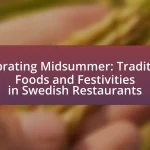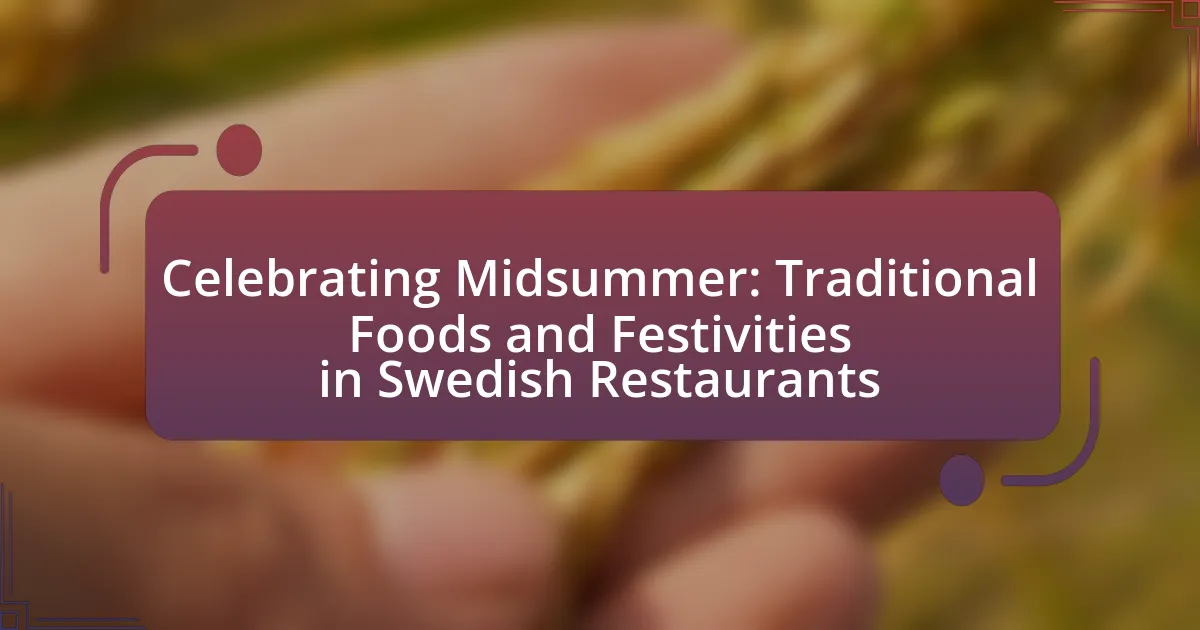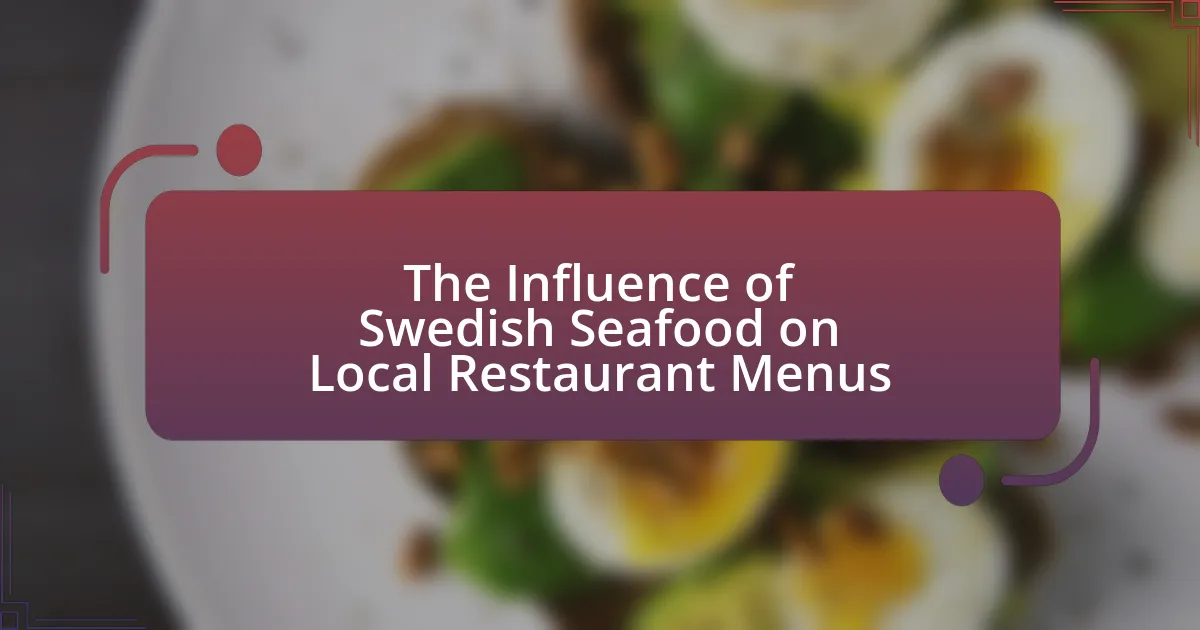The Smorgasbord is a traditional Swedish buffet that showcases a diverse array of cold and hot dishes, reflecting the country’s culinary heritage and agricultural abundance. Originating in the 16th century, it evolved from a simple spread of appetizers to a communal dining experience that promotes social interaction during celebrations and gatherings. The article explores the historical development of the Smorgasbord, its key components, the influence of social customs, and the role of seasonal ingredients. Additionally, it examines how globalization and regional variations have shaped contemporary practices, highlighting the Smorgasbord’s significance in Swedish culture and its integral role in festive occasions.
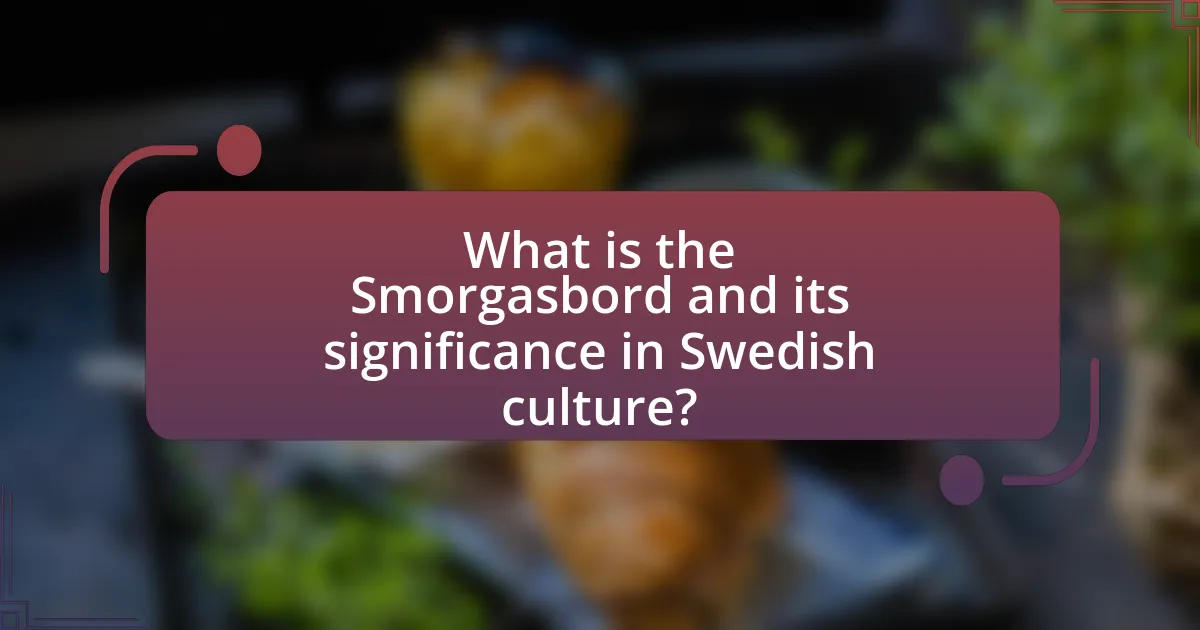
What is the Smorgasbord and its significance in Swedish culture?
The Smorgasbord is a traditional Swedish buffet that features a variety of dishes, including cold and hot items, showcasing the diversity of Swedish cuisine. Its significance in Swedish culture lies in its role as a communal dining experience, promoting social interaction and celebration during gatherings such as holidays and special occasions. Historically, the Smorgasbord evolved from the 19th-century practice of serving appetizers before the main meal, and it has become a symbol of Swedish hospitality and culinary heritage, reflecting the country’s agricultural abundance and culinary creativity.
How did the Smorgasbord originate?
The Smorgasbord originated in Sweden as a traditional buffet-style meal that combines various dishes, allowing diners to sample multiple flavors. This culinary practice dates back to the 16th century, where it began as a simple spread of appetizers served before the main course, known as “smörgås.” Over time, it evolved into a more elaborate buffet featuring a wide array of cold and hot dishes, reflecting Sweden’s rich culinary heritage. The term “smorgasbord” itself translates to “sandwich table,” highlighting its roots in serving bread and toppings. This evolution was influenced by social customs and the desire for communal dining experiences, making it a staple in Swedish culture.
What historical events influenced the development of the Smorgasbord?
The development of the Smorgasbord was influenced by several historical events, particularly the rise of the Swedish agricultural economy in the 16th century and the subsequent cultural exchanges during the 19th century. The 16th century saw an increase in food production and variety, leading to the practice of serving multiple dishes at gatherings. Additionally, the 19th century brought about the influence of the European buffet style, which integrated into Swedish dining customs, further shaping the Smorgasbord into a communal dining experience. These events collectively contributed to the evolution of the Smorgasbord as a distinct culinary tradition in Sweden.
How did social customs shape the Smorgasbord tradition?
Social customs significantly shaped the Smorgasbord tradition by promoting communal dining and the sharing of diverse dishes. In Sweden, the practice of gathering for meals has deep roots in social interactions, where families and friends come together to celebrate occasions, fostering a sense of community. This tradition evolved to include a variety of foods, reflecting local ingredients and culinary practices, which encouraged the inclusion of multiple dishes on the table. Historical evidence shows that during the 19th century, the Smorgasbord became popularized in restaurants, aligning with the social custom of leisurely dining and hospitality, where hosts would showcase their culinary skills and generosity. This transformation solidified the Smorgasbord as a cultural symbol of Swedish hospitality and social cohesion.
What are the key components of a traditional Smorgasbord?
A traditional Smorgasbord consists of a variety of cold and hot dishes, typically including herring, cured meats, cheeses, bread, and various salads. The cold dishes often feature pickled herring in multiple preparations, such as mustard or onion, while cured meats may include gravlax and various sausages. Cheeses are usually served alongside crispbread or rye bread, and salads can range from potato salad to beetroot salad. This buffet-style meal reflects Sweden’s culinary heritage and communal dining culture, emphasizing a diverse selection of flavors and textures.
What types of dishes are typically included in a Smorgasbord?
A Smorgasbord typically includes a variety of dishes such as herring, cured meats, cheeses, bread, and salads. This traditional Swedish buffet showcases a range of flavors and textures, often featuring pickled herring in different marinades, various types of cold cuts like gravlax and ham, an assortment of cheeses, and freshly baked breads. Additionally, salads such as potato salad and beetroot salad are common, reflecting the diverse culinary heritage of Sweden. The inclusion of these dishes highlights the Smorgasbord’s role in Swedish culture as a communal dining experience that emphasizes variety and abundance.
How do seasonal ingredients play a role in Smorgasbord offerings?
Seasonal ingredients are essential to Smorgasbord offerings as they enhance the freshness and variety of dishes presented. The use of ingredients that are in season allows for a diverse array of flavors and textures, reflecting the local agricultural cycles and traditions. For instance, spring Smorgasbords often feature fresh herring, new potatoes, and asparagus, while autumn spreads may include root vegetables, mushrooms, and game meats. This seasonal approach not only supports local farmers but also ensures that the dishes are at their peak in terms of taste and nutritional value, aligning with the Swedish culinary philosophy of utilizing what is readily available at different times of the year.
Why is the Smorgasbord considered a communal dining experience?
The Smorgasbord is considered a communal dining experience because it encourages sharing and interaction among diners. This buffet-style meal allows guests to serve themselves from a variety of dishes, fostering a social atmosphere where people can gather, converse, and enjoy food together. Historically, the Smorgasbord originated in Sweden, where it was traditionally served at celebrations and gatherings, reinforcing its role as a communal dining practice that promotes togetherness and shared enjoyment of diverse culinary offerings.
How does the layout of a Smorgasbord encourage social interaction?
The layout of a Smorgasbord encourages social interaction by promoting movement and engagement among guests. The arrangement of food stations requires diners to get up, walk around, and interact with others as they serve themselves. This design fosters conversations and connections, as people often discuss their food choices and share recommendations. Additionally, the communal nature of the buffet allows for a relaxed atmosphere where guests can gather, mingle, and enjoy the experience together, enhancing social bonds.
What rituals or etiquette are associated with enjoying a Smorgasbord?
Enjoying a Smorgasbord involves specific rituals and etiquette that enhance the dining experience. Diners typically begin by selecting a plate and moving through the buffet line, where they are encouraged to sample a variety of dishes, including cold and hot items, seafood, meats, and breads. It is customary to start with lighter fare, such as herring or salads, before progressing to heavier dishes.
Guests should also be mindful of portion sizes, taking small amounts to allow for multiple tastings, and it is polite to wait for others before starting to eat. Additionally, sharing dishes and engaging in conversation is encouraged, reflecting the communal aspect of the meal. Historically, the Smorgasbord originated as a way to showcase a variety of foods, and this tradition of abundance and sharing remains central to the experience.

How has the Smorgasbord evolved over time?
The Smorgasbord has evolved from a simple Swedish meal of bread and butter served with herring into a diverse buffet featuring a wide array of dishes. Initially, in the 16th century, it was primarily a way to showcase local fish and bread, but by the 19th century, it expanded to include meats, cheeses, and hot dishes, reflecting regional culinary influences. The introduction of the buffet style in the 1930s further transformed the Smorgasbord, allowing diners to serve themselves from a variety of options, which enhanced its popularity both in Sweden and internationally. This evolution illustrates the Smorgasbord’s adaptability and its role in social dining experiences.
What changes have occurred in Smorgasbord practices in modern Sweden?
Modern Smorgasbord practices in Sweden have evolved to include a greater emphasis on sustainability and local ingredients. Traditional Smorgasbord, which historically featured a wide array of dishes, has seen a shift towards seasonal and organic produce, reflecting contemporary dietary preferences and environmental concerns. Additionally, the presentation of Smorgasbord has become more refined, with a focus on aesthetics and gourmet elements, catering to a more diverse and health-conscious clientele. This transformation aligns with Sweden’s broader culinary trends that prioritize quality and sustainability in food preparation and consumption.
How has globalization influenced the Smorgasbord?
Globalization has significantly influenced the Smorgasbord by introducing diverse culinary elements from various cultures into this traditional Swedish buffet. As international travel and trade expanded, ingredients and dishes from around the world became accessible in Sweden, allowing for the incorporation of flavors and techniques that were previously unavailable. For instance, the integration of Asian, Mediterranean, and Middle Eastern cuisines into Smorgasbord offerings reflects this global exchange, enhancing the variety and appeal of the buffet. This evolution demonstrates how globalization has transformed the Smorgasbord from a purely Swedish experience into a multicultural dining event, showcasing a blend of global culinary traditions.
What contemporary variations of the Smorgasbord exist today?
Contemporary variations of the Smorgasbord include buffet-style dining, tapas bars, and all-you-can-eat restaurants. Buffet-style dining allows guests to serve themselves from a wide array of dishes, similar to the traditional Smorgasbord, while tapas bars focus on small plates of various dishes, encouraging sharing and sampling. All-you-can-eat restaurants offer a fixed price for unlimited access to a variety of foods, reflecting the communal and abundant nature of the Smorgasbord tradition. These modern adaptations maintain the essence of the original concept by promoting variety and social dining experiences.
How do regional differences affect Smorgasbord traditions?
Regional differences significantly influence Smorgasbord traditions by shaping the variety of dishes served and the cultural practices surrounding the meal. In Sweden, for instance, coastal regions often feature an abundance of seafood, such as herring and salmon, reflecting local fishing practices, while inland areas may emphasize meat dishes like cured meats and game, showcasing agricultural resources. Additionally, regional festivities and seasonal ingredients further diversify the Smorgasbord, with specific dishes associated with holidays or local customs, such as the Christmas Smorgasbord that includes unique items like Janssons frestelse (a potato and anchovy casserole). This regional variation highlights how local geography and culture directly impact the Smorgasbord experience, making it a reflection of Sweden’s diverse culinary landscape.
What unique dishes are found in regional Smorgasbord variations?
Regional Smorgasbord variations feature unique dishes such as herring prepared in various styles, including mustard herring and herring in wine sauce, which are staples in Swedish cuisine. Additionally, regions may include local specialties like gravlax, a cured salmon dish, and köttbullar, or Swedish meatballs, often served with lingonberry sauce. These dishes reflect the local ingredients and culinary traditions, showcasing the diversity within the Smorgasbord experience across Sweden.
How do cultural influences shape regional Smorgasbord styles?
Cultural influences shape regional Smorgasbord styles by integrating local ingredients, traditions, and culinary practices into the buffet format. For instance, in coastal regions of Sweden, seafood such as herring and salmon is prominently featured, reflecting the area’s fishing heritage. In contrast, inland regions may emphasize meat dishes, showcasing local game and agricultural products. Historical events, such as trade routes and migrations, have also introduced diverse flavors and cooking techniques, further enriching the Smorgasbord experience. This adaptability allows each region to express its unique identity through the Smorgasbord, making it a dynamic representation of local culture and history.
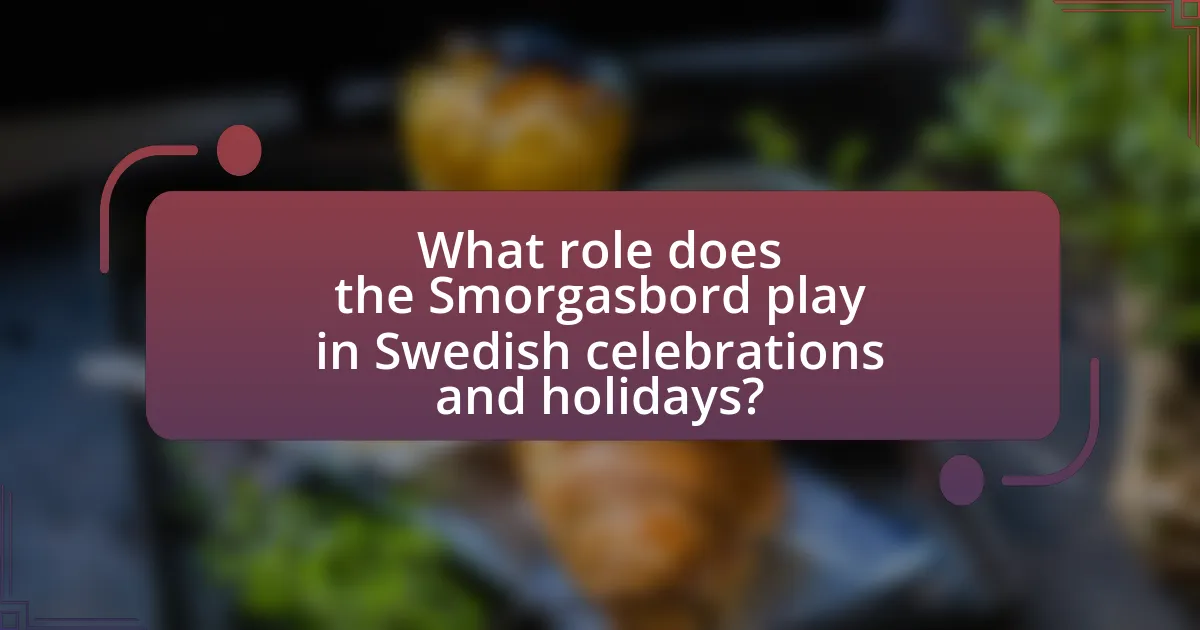
What role does the Smorgasbord play in Swedish celebrations and holidays?
The Smorgasbord plays a central role in Swedish celebrations and holidays by serving as a traditional buffet that showcases a variety of dishes, symbolizing abundance and hospitality. During significant occasions such as Christmas, Midsummer, and weddings, the Smorgasbord features an array of foods including herring, meatballs, and cured salmon, reflecting Sweden’s culinary heritage. This communal dining experience fosters social interaction and togetherness, reinforcing cultural traditions. Historically, the Smorgasbord has roots in the 19th century, evolving from a simple spread of appetizers to a lavish display of Swedish cuisine, making it an integral part of festive gatherings.
How is the Smorgasbord featured in traditional Swedish festivities?
The Smorgasbord is a central feature of traditional Swedish festivities, serving as a buffet-style meal that showcases a variety of dishes. This culinary tradition is particularly prominent during celebrations such as Christmas, Midsummer, and weddings, where it allows guests to sample an array of foods, including herring, meatballs, and various breads. Historically, the Smorgasbord evolved from the Swedish “smörgås,” meaning open-faced sandwiches, and has been a staple in Swedish culture since the 18th century. Its inclusion in festivities emphasizes communal dining and the celebration of Swedish culinary heritage, making it a vital aspect of social gatherings.
What specific holidays prominently feature the Smorgasbord?
The Smorgasbord prominently features during Swedish holidays such as Christmas, Midsummer, and Easter. During Christmas, the Smorgasbord, known as “Julbord,” includes traditional dishes like herring, meatballs, and ham. Midsummer celebrations feature a Smorgasbord with fresh herring, new potatoes, and strawberries, reflecting seasonal ingredients. Easter, or “Påsk,” also showcases a Smorgasbord with dishes like pickled herring and lamb, celebrating the holiday’s themes of renewal and festivity. These holidays highlight the cultural significance of the Smorgasbord in Swedish culinary traditions.
How do family gatherings incorporate the Smorgasbord tradition?
Family gatherings incorporate the Smorgasbord tradition by serving a variety of dishes that reflect Swedish culinary heritage, allowing guests to sample multiple flavors and textures. This buffet-style meal encourages communal dining and social interaction, as family members can choose their preferred items from an extensive spread, which typically includes herring, meatballs, and various breads. The Smorgasbord tradition is rooted in Swedish culture, where it originated as a way to showcase seasonal ingredients and foster a sense of togetherness during festive occasions.
What are some popular Smorgasbord recipes for special occasions?
Popular Smorgasbord recipes for special occasions include herring dishes, meatballs, and gravlax. Herring, often pickled or marinated, is a staple in Swedish cuisine and is typically served in various flavors such as mustard or onion. Swedish meatballs, made from a mixture of ground beef and pork, are commonly accompanied by lingonberry sauce and creamy gravy. Gravlax, a cured salmon dish seasoned with dill and sugar, is another favorite that showcases traditional Swedish flavors. These recipes reflect the rich culinary heritage of Sweden and are often featured during festive gatherings and celebrations.
How can one prepare a traditional Smorgasbord at home?
To prepare a traditional Smorgasbord at home, one should include a variety of cold and hot dishes that reflect Swedish culinary traditions. Essential components typically consist of herring prepared in different styles, cured salmon, meatballs, and a selection of cheeses and breads.
For instance, herring can be pickled in various flavors such as mustard or onion, while the cured salmon, known as gravlax, is often served with a mustard-dill sauce. Meatballs, a staple in Swedish cuisine, should be seasoned with spices like allspice and served with lingonberry sauce.
Additionally, including a variety of breads, such as crispbread and rye, along with cheeses like Västerbotten, enhances the experience. Traditional accompaniments may also feature potato salad, beetroot salad, and a selection of pickled vegetables.
This approach aligns with the historical context of Smorgasbord, which originated as a way to showcase a range of dishes, allowing guests to sample multiple flavors in one meal.
What tips can enhance the Smorgasbord experience for guests?
To enhance the Smorgasbord experience for guests, it is essential to encourage them to sample a variety of dishes in small portions. This approach allows guests to appreciate the diverse flavors and textures that characterize this traditional Swedish buffet. Additionally, providing clear labels for each dish can help guests make informed choices based on their dietary preferences and restrictions. Research indicates that a well-organized buffet with visible options increases guest satisfaction and encourages exploration of new foods. Furthermore, incorporating seasonal and locally sourced ingredients can elevate the overall quality and authenticity of the Smorgasbord, making the dining experience more memorable.


